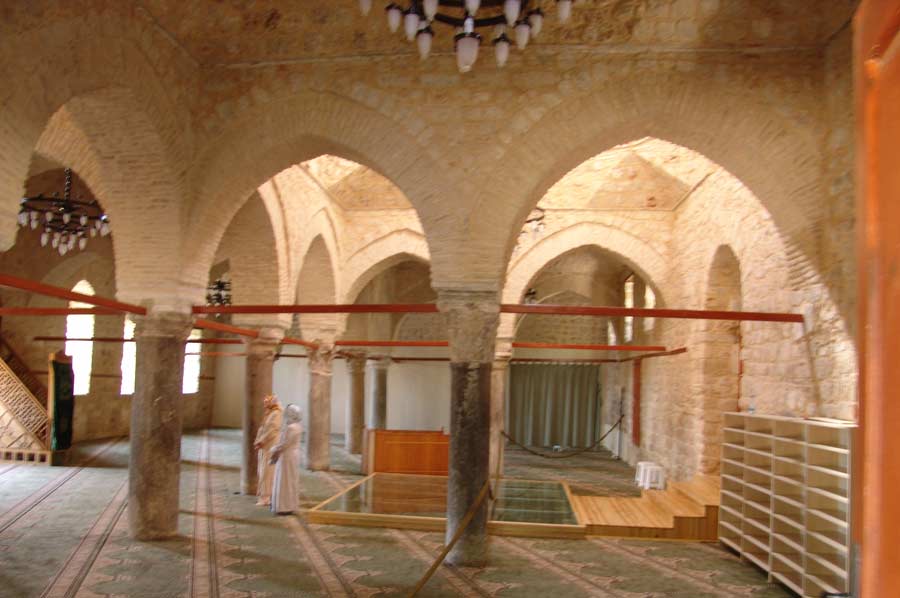Turkey – Mediterranean West (Antalya, Isparta, Burdur, Alanya) December 19-20, 2019
ALANYA
This is a large beach resort city on the Mediterranean coast.
Tentative WHS: Alanya (25/02/2000)
Ataturk House Museum. Ataturk visited Alanya on February 17, 1935, arriving at 07:00 and leaving at 10:30. He visited this house but never slept here. It has memorabilia (he must have divided his wardrobe around the hundreds of Ataturk museums in Turkey), a few photos, but primarily has local ethnographic material and is furnished in period furniture. Free
Damlataş Cave (“Dripping Cave”). Discovered in 1948 when opening a rock quarry, it is a constant 22.5°C and 98% humidity. Mostly one large small cavern, it has several columns and a ceiling dripping with thin stalactites. Almost everything within reach of a ladder is broken off. A very low-roofed passage with no features leads off the end. TL7
Cleopatra Beach. The main beach of Alanya, it is a deep, tan sand beach with restaurants and bars. On a gorgeous sunny, 19°C day in mid December, many were sunbathing.
Alanya Cable Car. Leaving from the beach, this enclosed car cable way goes up to Alanya Castle. TL28 round trip
Alanya Castle. Surrounded by walls with 6 km lengths and situated on 10 hectares of a peninsula, Castle of Alanya hosted Hellenistic, Roman, Byzantine, Seljuk and Ottoman civilizations. First mentioned in the 4th century BC mentioned as Coracesium. Coracesium by convenience of its natural defense and its sheltered port even with a small military became a harbor and center of the piracy in 2nd century BC, ideal for pirates and rebels. In 65 BC, pirate dominance ended with Coracesium war, which resulted the victory of Roman Pompeius. The city in Roman time grew by expansion of walls and addition of new buildings.
Alanya Castle in Byzantine time with the name of Kalonoros (the beautiful mountain) became a location point for sailors and the busiest port of the Mediterranean. Church in the castle (İçkale), Arap Evliyası, ruins of monastery at Cilvarda point and remains of round – towered wall continued from Middle Fortress (Orta Hisar) to the castle (İçkale) belong to Byzantine period.
In 1221, Kalonoros was assigned to Alaeddin Keyqubad I, Anatolian Seljuk Sultan who began big construction activities, solidified old walls, built new walls and gave the golden age to Alanya. Today’s existing walls, large cisterns, shipyard, Red Tower, Cannon House, Akşebe tomb and palace complex in the castle (İçkale) are some of the works built by Alaeddin. Ehmedek, Akşebe Small Mosque, Andızlı Mosque, Seljuk and Lower Castle (Asagi Kale) Baths were constructed during Seljuk’s time. By gaining Alanya, Anatolian Seljuk sultanate had a strong castle in coast of the Mediterranean as well as a strong foundation in both the sea and the land. Alaiye reached a specific status in developing internal, external and transit trade.
Alaiye in the first half of the 14th century remained among important cities of Anatolia and the Mediterranean by an essential naval base as a leading commercial city of Anatolian Seljuk and as a center of trade and shipbuilding by a strong relations with Egypt and Syria. Mostly Egyptian merchants who came for famous cedars used in the construction of the ships as well as Genoese, Venetian and Florentine merchants bought spices, canvas and sugar.
Alaiye felt into the Kingdom of Cyprus for a short period after the collapse of Seljuk Sultanate (1293) and then came under the dominance of Ottoman after Karaman and Alaiye principality (1471). Süleymaniye Mosque, covered market with Ottoman bazaar at Upper Castle (Yukari Kale) and traditional Alanya houses are monuments of Ottoman period.
On the hill on the east side of the city overlooking the sea, its battlements encircle the cliffs.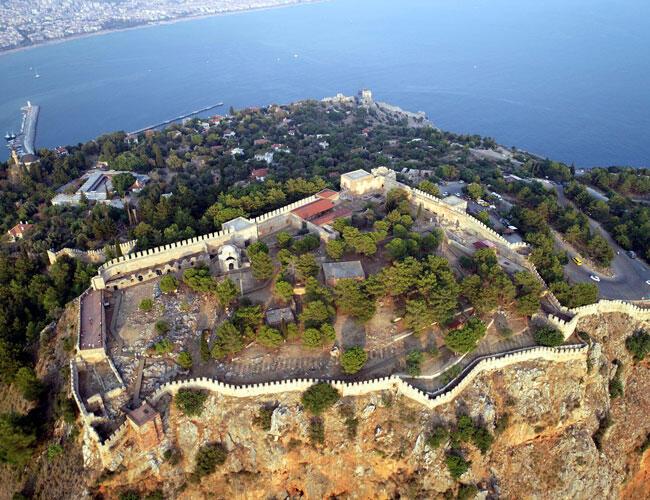 Alanya Gardens. Mostly trees lined by flowerbeds, these gardens line the ocean boulevard.
Alanya Gardens. Mostly trees lined by flowerbeds, these gardens line the ocean boulevard.
The drive west of Alanya to Atlanya, is often high up in the mountains because of the rugged coastline. It drops down to the towns, almostly completely taken up by greenhouse complexes. Prickly pear cactus, palm trees, banana plantations and pine forests dominate the landscape.
Manavgat Waterfall. In the north outskirts of Manavgat, these small falls aren’t visible at high water and merely a cataract.
The Theatre and Aqueducts of the Ancient City of Aspendos (13/04/2015). The theatre is probably the best preserved in the Roman world. Built in (160-180AD), the 100m long façade (the back of the stage) dominates the parking lot. The 3-story stage is intact except for the absent statues and fractured friezes on the platforms. It held 9000 people in 41 rows of seats divided into two sections. The arcade across the top has been partially reconstructed to make it completely intact, which is very unusal.
The rest of the site is ruins, a stadium with little intact, some high walls remaining of the agora above the theatre on the hill and the aqueduct.
_15RA1H2ULLTN520B7XAC3GPDLFRV9M.jpg)
ARCHAEOLOGICAL SITE of PERGE. Tentative WHS (06/02/2009)
Perge, one of the Pamphylian cities and was believed to have been built in the 12th to 13th centuries BC. After coming under the rule of Lydia and Persia, the city surrendered to Alexander the Great in 334 BC. The brightest era of the city was during the reign of the Romans in the 2nd to 3rd centuries AD.
Ancient Perge is famous by the fact that when Saint Paul started his journeys, he visited Perge in 46 AD. and preached his first sermon here. That is why it became an important city for the Christians during Byzantine period.
All the remains of the city can be seen in this area. Social and cultural buildings reflecting the majesty of the Perge Ancient City are the necropolis, theatre, city walls, stadium, gymnasium, Roman baths, rectangular planned agora, high towers, monumental fountains, column lined streets, Greek and Roman gates.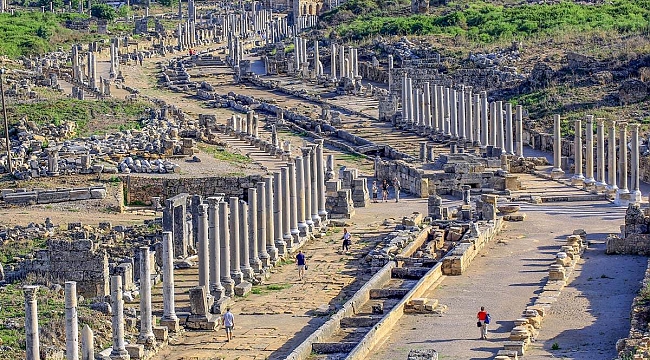 Basilica and Baths: The first entrance to the city is the Roman gate of the later period. On the right there is a Byzantine basilica. After the basilica comes the agora and on the left there are baths. Among the cities of Pamphylia the largest and most glamorous baths were to be found in Perge.
Basilica and Baths: The first entrance to the city is the Roman gate of the later period. On the right there is a Byzantine basilica. After the basilica comes the agora and on the left there are baths. Among the cities of Pamphylia the largest and most glamorous baths were to be found in Perge.
City Walls: There are two walls that run parallel to each other have become the symbol of Perge and are dated to the 3rd century BC. The oldest gate of the city is in these walls as well as two towers, all from the Hellenistic period. After the Hellenistic gate comes a colonnaded street.
Theatre and Stadium: The theatre is away from the historical site is the first view of the city you have on the road when approaching the entrance. Behind the theatre is the impressive and large stadium, which is principal structure of the ancient city of Perge. It is one of the best preserved stadiums of the ancient world and the second largest after the stadium in the ancient city of Aphrodisias.
Through a series of mishaps, I blew all the fuses to my plug in sockets thus eliminating any power source for my computer. After only getting frustrated with the VW dealer in Alanya, I lucked out with an auto electrical supply shop. The guy was a genius finding a third fuse box under the seat, replaced all the fuses, sold me four more and only charged TL50 (about €8).
ANTALYA
Düden Waterfalls.
Kurşunlu Waterfall. This a major tourist attraction has its own park, but not much of a waterfall – 5 small falls coming out of a lot of bush. TL8
Markantalya Avm Shopping Center. A five-level mall built in a rectangle, cinemas are on the top, next the food court. All the usual stores.
Antalya Bazaar. This typical bazaar offers food, clothing and knick-knacks at cheap prices but apparently raised for foreigners.
Yivliminare Mosque. This is a wonderful mosque inside with six white stone domes supported by 2 rows of marble columns with Corinthian capitals. The unusual red brick minaret has 8 round facets. Unique water pipes are exposed under the floor revealed in a recent restoration. TL36
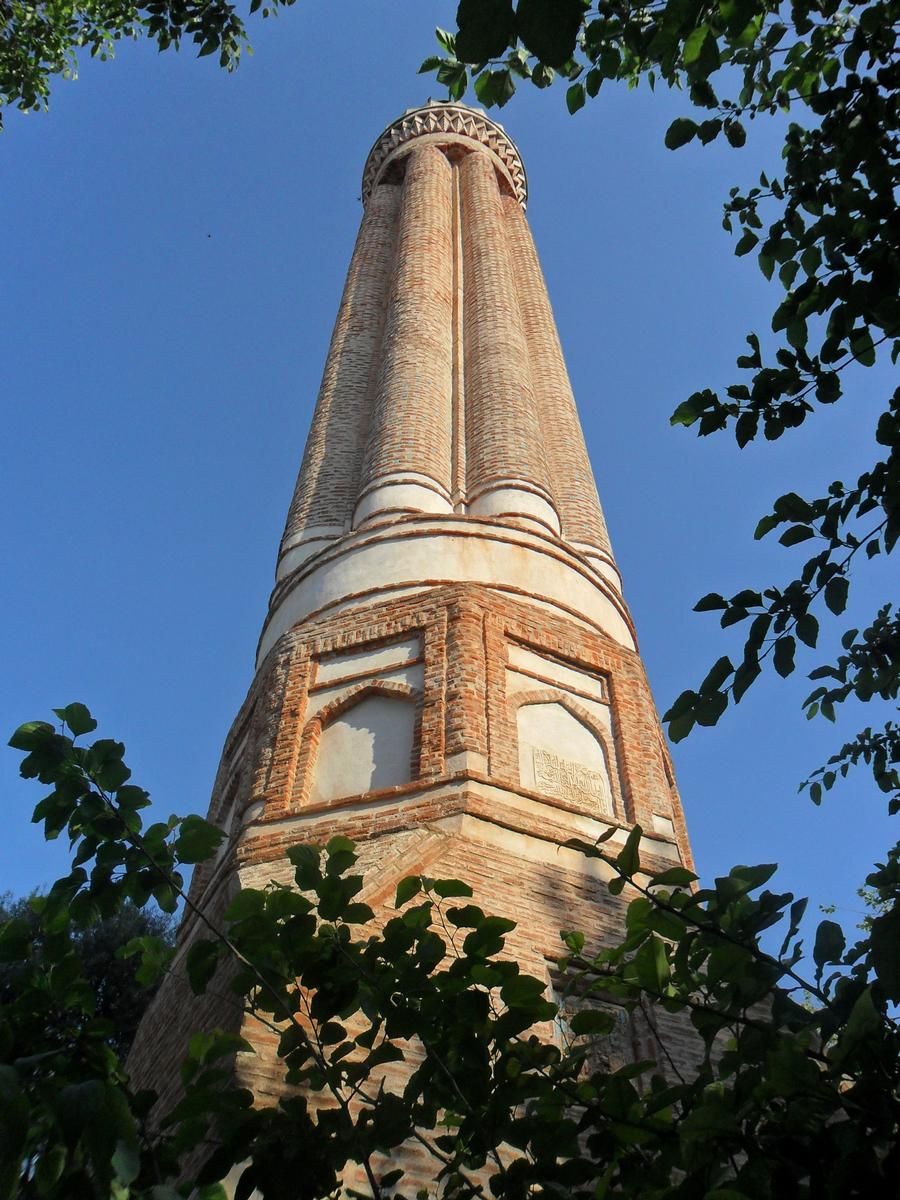
Antalya Marine Biology Museum. In an obscure tiny building on the waterfront, it appears to never be open. This area though is very pretty with sidewalk cafes and boats with statues adorning the backs.
Antalya Museum. On the west side of town, it has the usual progression of the Ages of Man archaeology. Their special exhibit is Coins of Anatolian Seljuks. Well presented. In the gardens is a huge display of statues, friezes and columns. TL36
Antalya Aquarium. A major tourist attraction with the largest aquarium tunnel in the world, a wax museum, tropical reptile world, submarine XD cinema, VR city tour and a McDonalds, plus a lovely building. TL35 just for the aquarium.
The drive from Antalya along the south coast Mediterranean of Turkey is gorgeous – rugged high mountains with the highest capped with snow, pine forests, lovely dramatic coastline and for parts a great 4 lane divided highway.
Olympos Cableway. The Telerferik goes to the snow capped summit of Tahtali mountain, at 2365m is the highest mountain closest to the sea, the second highest in the Beydag National Park and dominates the coastline. Climb the brick road for 7kms off the highway. Using large enclosed cars, this is very popular with tourists, especially Orientals. Trips every 30 minutes with stops for 15 minutes on top. It is a rugged white limestone mountain, great 360° panoramas. Paragliding is offered in season. Clouds below obscured some of the coastline. €25
St. Nicholas Church (25/02/2000). Important to both Greek and Russian Orthodox churches, he was born in Patara, one of the Lycian ports, in the late 3rd century and lived there until becoming bishop of Myra (Demre). He performed miracles and protected children, seamen, travelers and poor men. Canonized after his death, he became patron saint of Greece and Russia. December 6, the day of his death, is celebrated by Christians.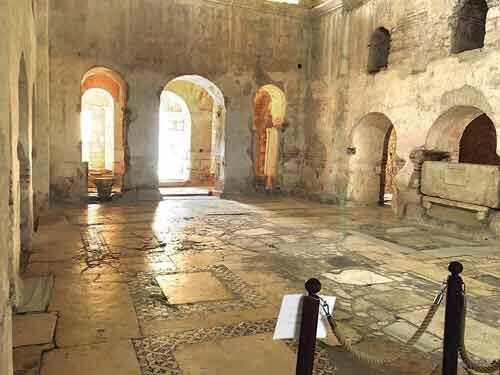
In the Byzantine and post-Byzantine periods, many churches were dedicated to him where Christian seamen lived especially in Freiburg, Germany, Bari and Naples, Italy and Sicily. He attended the first council in Nicaea.
St Nicholas Church. Myra became the capital of Lucia Province in the Emperor Theodosius II period (4980450). After a large earthquake in 529, Emperor Justinianos (527-65) had the original building repaired. It was reconstructed after an earthquake and enemy attacks in the 8th century as a domed basilica in the 9th century. Subsequently there were many repairs and an annex added. In the 11th century, the narthex was painted. The most important restoration occurred in 1042-55. 12th century paintings are in sepulcher with a communion scene. A bishops building and annexes to the north were built in the 11th and 12th centuries. A flood of the Myros River in the late 12th century filled the church making the ground level 6m higher and the church is not below ground level. A bell tower was constructed in the 19th century. It was covered by a steel and plastic roof in 1968.
The highlights are the many stone domes and the lovely 13th century marble floor with mosaics done in the opus sectile technique.
TL36
It was another long drive to make sure I could make the ferry to Rhodes from Marmaris, Turkey. The ferry, a superfast catamaran, left at 09:45 and departed Rhodes at 15:00 Greek time (one hour later), giving me only 6 hours in Rhodes. But it was more than enough time to see the Medieval City of Rhodes. The modern city has little special other than being a typical tourist city.
NOMAD MANIA Turkey – Mediterranean West (Antalya, Isparta, Burdur, Alanya)
World Heritage Sites: Xanthos-Letoon
Tentative WHS
Alanya (25/02/2000)
Ancient Cities of Lycian Civilization (06/02/2009)
Ancient city of Kibyra (13/04/2016)
Archaeological Site of Perge
Archaeological Site of Sagalassos (06/02/2009)
Güllük Dagi-Termessos National Park (25/02/2000)
Karain Cave (01/02/1994)
Kekova (25/02/2000)
Seljuk Caravanserais on the route from Denizli to Dogubeyazit (25/02/2000)
St. Nicholas Church (25/02/2000)
The Theatre and Aqueducts of the Ancient City of Aspendos (13/04/2015)
Yivli Minaret Mosque (13/04/2016)
Sights: Eğridir Lake
Borders: Turkey (sea border/port)
Airports: Gazipasa (GZP)
Railway, Metro, Funiculars, Cable Cars: Olympos Cableway
Museums: Burdur Museum
World of Nature: Koprulu Canyon
Festivals: Aspendos International Opera and Ballet Festival
Kaputas Beach
Kemer: Cirali Beach
Waterfalls: Manavgat Waterfall’
Ski Resorts: Saklikent Ski Resort
Villages and Small Towns: Kaş
Cities of Asia and Oceania
ALANYA
Tentative WHS: Alanya (25/02/2000)
Railway, Metro, Funiculars, Cable Cars: Alanya Cable Car
House Museums/Plantations: Alanya: Ataturk House Museum
Castles, Palaces, Forts: Alanya Castle
Botanical Gardens: Alanya Gardens
Festivals: Alanya International Culture and Art Festival
Caves: Damlataş Cave
Beaches: Cleopatra’s Beach
ANTALYA World City and Popular Town
Sights: Antalya Coast
Airports: Antalya (AYT)
Railway, Metro, Funiculars, Cable Cars
Antalya nostalgic tramway
Antalya: AntRay
Museums
Antalya Marine Biology Museum
Antalya Museum
Religious Temples: Yivliminare Mosque
Entertainment/Things to do: Sandland
Aquariums: Antalya Aquarium
Malls/Department Stores: Markantalya Avm
Markets: Antalya Bazaar
Waterfalls
Düden Waterfalls
Kurşunlu Waterfall
ISPARTA
Airports: Isparta (ISE)
Museums: Isparta Ethnography and Carpet Museum
